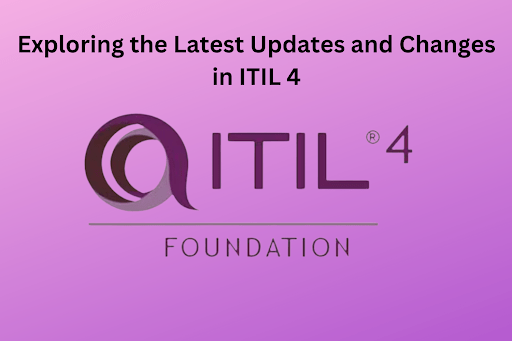What is ITIL? It has been a core component of IT Service Management (ITSM) for a very long time.
ITIL (Information Technology Infrastructure Library) has seen major modifications to stay updated and relevant in the digital world due to the rapid development of IT deployment to run business operations.
ITIL Foundation Certification is a great method to get started on the basics of ITIL. This blog will delve into the most recent ITIL 4 updates and modifications.
Evolution of ITIL
ITIL was first used in 1986 and has proved to be the most popular framework for ITSM practices to be used in many countries. Although ITIL has been revisited, ITIL 4 is the latest edition.
ITIL 4 is not a substitute for earlier revisions; rather, it is an evolution of the framework that includes new IT industry practices and ideas. This strategy guarantees that the structure will always be applicable and efficient in meeting the evolving requirements of IT service management.
Key Changes in ITIL 4
The following are the major changes in ITIL 4:
- Focus on integrating with Agile and DevOps frameworks.
- Recognises IT services as part of a larger digital ecosystem.
- Encourages holistic management due to interdependencies between components and stakeholders.
Guiding Principles
Underlying the framework is a set of fundamental principles known as the guiding principles of ITIL 4. These ideas are meant to direct IT professionals in making decisions and guarantee that IT services meet the requirements of the company. The guiding ideas comprise:
Focus on Value
IT services should be made to benefit both the company and its clients.
Direct and Indirect Focus
The management of IT services should aim to provide the company with both direct and indirect advantages.
Collaboration and Communication
IT services should be controlled via cooperation and transparent communication among interested parties.
Applying Technology
To increase effectiveness and efficiency, IT services need to use technology.
Working Holistically
IT services need to be handled considering interdependencies and the demands of stakeholders as a part of a larger digital ecosystem.
Benefits of ITIL 4 Adoption
Some of the major benefits of incorporating ITIL in your organization is explained below.
Improved Service Delivery
ITIL 4 offers a methodical way to oversee IT services, which raises both customer happiness and service quality.
Enhanced Efficiency
ITIL 4 assists companies in simplifying their IT operations and increase efficiency by emphasizing practices over procedures.
Better Alignment with Business Goals
To guarantee that IT contributes to overall business success, ITIL 4’s guiding principles stress the need of matching IT services with the strategic goals of the company.
Increased Flexibility
ITIL 4’s inclusion of Agile and DevOps techniques enables organisations to react more quickly and adaptably to shifting business requirements.
Enhanced Collaboration
ITIL 4 encourages cooperation and dialogue between several parties, therefore promoting a shared responsibility and teamwork culture.
Implementation Strategies for ITIL 4
ITIL 4 implementation done right demands meticulous preparation and execution. For companies considering ITIL 4, the following are important tactics
Assess Current State
Find out what needs to be improved and how much of ITIL 4 should be implemented by thoroughly evaluating the ITSM processes in your company now.
Engage Stakeholders
Participate in the implementation process by incorporating important stakeholders from all around the company to guarantee support and buy-in for the changes.
Training and Education
To guarantee IT employees have the abilities and information required to successfully adopt ITIL 4, provide them with training and education.
Pilot Projects
Before extending the ITIL 4 deployment throughout the company, start with pilot projects to evaluate the new procedures and concepts.
Continuous Improvement
To guarantee that ITIL 4 procedures are routinely evaluated and optimised to suit evolving business needs, establish a culture of continuous improvement.
Certification Scheme
The certification scheme for ITIL 4 has also undergone significant changes. The following is the newly adopted scheme-
- Includes five levels- Foundation, Specialist Modules, Strategist, Leader and Master of ITIL.
- These schemes provide comprehensive understanding of ITIL application in various contexts.
Conclusion
The most recent revisions to ITIL 4 mirror how IT service management is changing in the digital world of today. ITIL 4 emphasises digital transformation, moves from processes to practices, and integrates ITIL with other frameworks. Understanding these developments will help IT professionals provide value to their companies and more skillfully negotiate the challenges of IT service management.




